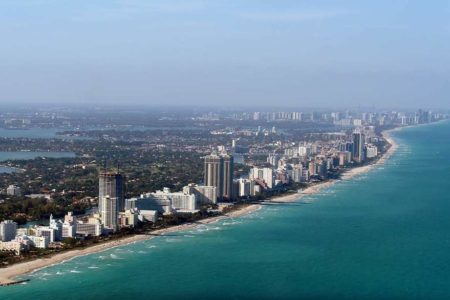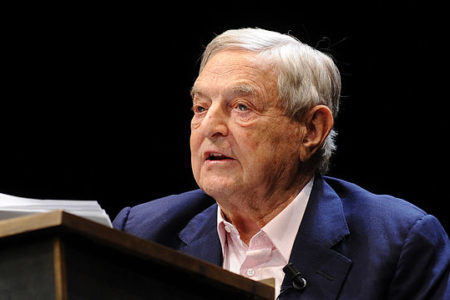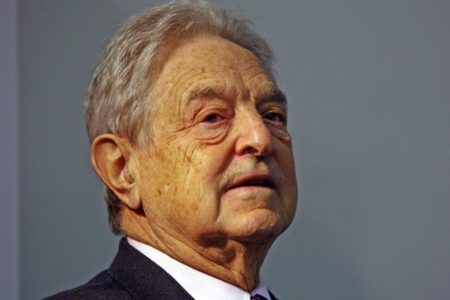
Photo Credit: Niccolò Caranti
The aged left-wing billionaire George Soros may not be long for this world. The same cannot be said for his determination to spread his brand of “open society democracy.” The Soros dynasty is set to continue funding radical movements across the world, and it’s bigger than ever.
The year 2017 will be remembered as a pivotal year for the organizations and foundations orbiting around George Soros. And not just because of Soros’ blockbuster October announcement that he was committing a whopping $18 billion in additional support to his Open Society Foundations. Conservative activist Grover Norquist, with tongue firmly in cheek, wondered if this meant Soros had second thoughts about paying death taxes on his estate.
2017 also provide hints about the potential roles Soros’ five children might play in their father’s foundations once he passes from the scene. With Soros having turned 87 in August, this leadership question looms ever larger. No one, not even Soros, can live forever.
Last year was a time of change for Soros’ Philanthropic Empire. In September came word that Open Society Foundations (OSF) President Christopher Stone would step down at the end of 2017, after 5 years, to make way for Patrick Gaspard. Gaspard is a former Obama Administration Ambassador to South Africa and Service Employees International Union political organizer.
It was also a year of controversies for Soros. In 2017, for example, questions emerged about the apparently high level of cooperation over the last few years between USAID, an official US government agency, and the Open Society group. There are indications the two have colluded in an effort to meddle in local politics in the tiny country of Macedonia, where the OSF network’s efforts have included distribution of an Macedonian-language translation of communist provocateur Saul Alinsky’s notorious Rules for Radicals.
This edition of Foundation Watch will review these and other developments, contextualize them, and attempt to draw insights about the future of the global Soros apparatus. If you weren’t paying attention to Soros before, or the outsized role his theatrically huge giving plays in fueling radical movements around the world, he’s just given you 18 billion reasons more to care.
The $18 Billion Gift
The news came in mid-October—George Soros will transfer $18 billion to his Open Society Foundation, making it the third-largest U.S. foundation. Much speculation followed about how the money will be used, what individuals, groups and causes it will benefit, and so on.
News of Soros’ $18 billion pledge came as a big surprise, but it may have been past and current beneficiaries of his foundations’ giving to whom this news was really shocking. Why? Because starting about 3 years ago, Open Society had publicly signaled that it did not expect its resources to grow considerably in future.
In October 2014, OSF president Christopher Stone used a webcast to Open Society grantees (published a month later on OSF’s YouTube channel under the title “Webcast on Grant Making with Chris Stone”). About 39 minutes into the webcast, in response to a question from a grantee, Stone says:
We’re very lucky in that we have a founder and chairman who made a lot of money in his life. But at about the same time he asked me to take this job, he told everyone in the network that he had retired from moneymaking, and we were now going to have to live within our means – by which he meant his means. The assets of the foundation and of George Soros has [sic] accumulated to put to the cause of Open Society are huge, but they are not limitless – and they are now essentially fixed.
So we are a very large foundation, but we are not growing – and we were growing for many years…and that’s a very different reality to work with. It meant that we could build new programs and make new projects without having to stop things we are doing. Today, to start something new, we have to slow up on something else.
Upon review of the six-page summary of OSF’s 2016 budget posted to the organization’s website, one finds little evidence of the foundation slowing down. OSF disclosed a $930.7 million total budget for the year but just 58% or $544 million went to grant-making. In addition to various administrative costs, salaries and benefits – which represent about 28% of OSF’s total budget – $132 million or 14% of the budget is earmarked for “grant-making reserves.”
These reserves “are meant to be spent on grants in the calendar year” and are “available to be allocated quickly for unanticipated opportunities,” according to the budget summary. “Each use of reserves during the year is approved by the chairman, by the chair of the Global Board’s budget committee, by the president, or by the chair of the board of U.S. Programs. All allocations of reserves are reported to the full Global Board at its regular meetings,” the document explains.
The document provides other helpful insights into OSF priorities. For example, by total dollar expenditure, the top 5 focus areas globally for OSF were: “Human Rights & Democratic Practice” ($142.1 million); “Economic Governance & Advancement” ($125 million); “Justice Reform & The Rule Of Law” ($53.3 million); “Economic Governance & Advancement” ($41.7 million); and “Health and Rights” ($35.7 million).
With $18 billion more in the bank, just imagine how much more “human rights” work OSF can undertake. That’s probably more than enough to translate Saul Alinsky’s Rules for Radicals into the world’s most obscure languages – no doubt a major step forward for “human rights” as understood by OSF. There must remote tribes living in the Amazon jungle, or the mountains of Central Asia, that have not yet been exposed to Alinsky’s words.
This compact budget summary points to what observer David Callahan of Inside Philanthropy believes will probably be Christopher Stone’s main legacy as OSF President: that he brought greater coherence and clarity to a complex internal budget process that involved more than 50 different entities affiliated under the “Open Society Foundation” banner.
This included the creation of a central Strategy Unit, led by Johanna Chao Kreilick, a former assistant to Stone. As described on OSF’s website, the office “facilitates the evolution of the Foundations’ strategy, budget, and assessment practice, and supervises a team providing strategy and assessment support to the Foundations’ 52 programs, foundations, and advocacy offices around the globe.”
Stone’s efforts created internal friction, some of it rich in irony: Callahan cites OSF’s New York and Baltimore staff’s June 2016 vote to unionize and join the Communications Workers of America.
In his introduction to The Philanthropy of George Soros (published in 2011), Soros elaborated the internal issues that Stone confronted when he began his term as president in 2012:
[a]s I survey my foundations network, I cannot give a proper accounting of the far-reaching and varied activities going on inside because I am not aware of all of them As I travel around I keep on discovering them, and they are a great source of satisfaction for me. The activities of which I am not aware are often the best; it is the problematic ones that are brought to my attention. Only Aryeh Neier [OSF’s President from 1993 to 2012] and a few others who participate in the budget review process are familiar with the whole range of activities – and the budget process takes six weeks to complete.” [emphasis added]






Recent Comments